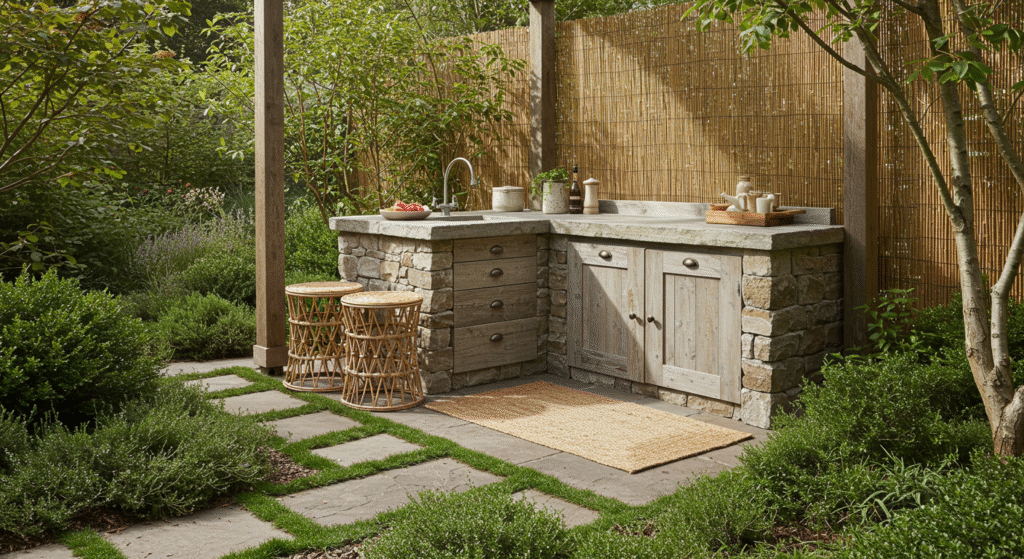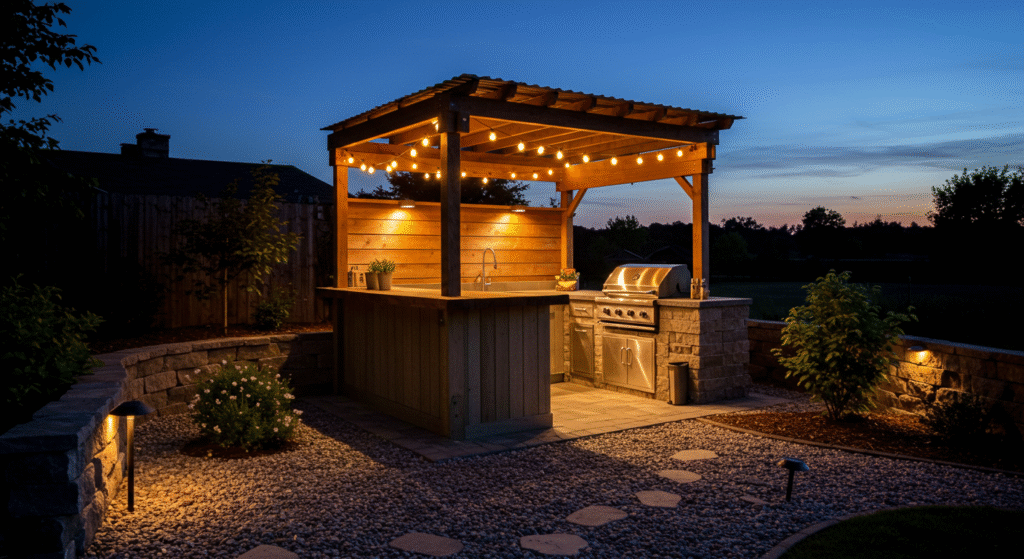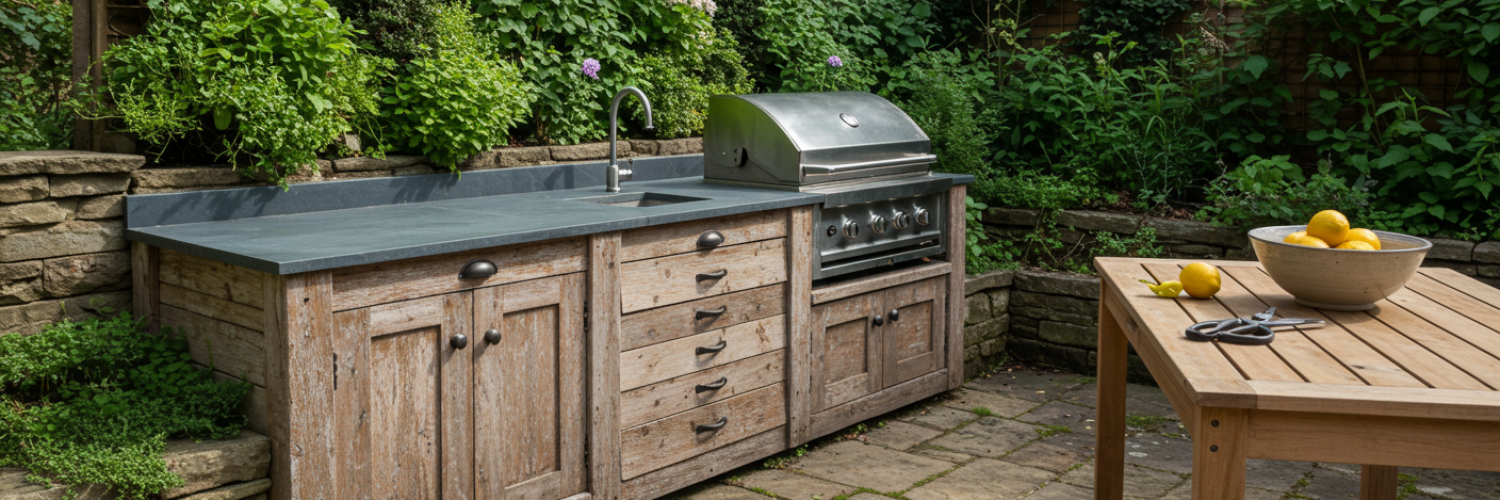In today’s world, homeowners are increasingly seeking ways to bring the outdoors in and take the indoors out. A small outdoor kitchen that harmonizes with the surrounding landscape offers the perfect solution for those with limited space but unlimited imagination.
By thoughtfully integrating greenery into your outdoor cooking area, you can create a refreshing, functional space that feels like a natural extension of your garden. At JH Landscapes, we’ve helped countless Charlotte homeowners transform modest outdoor areas into stunning cooking spaces that embrace nature’s beauty.
This guide explores creative approaches to designing small outdoor kitchens that celebrate and incorporate the natural environment, making even the most compact spaces feel expansive and inviting.
Experience the Wellness Benefits of Nature-Integrated Outdoor Kitchens
When you blend your outdoor kitchen with natural elements, you’re doing more than just creating an attractive cooking space. You’re establishing a multi-sensory experience that enhances your outdoor living. Natural integration offers numerous advantages that go beyond aesthetics.
First, incorporating plants and natural materials helps regulate the microclimate around your cooking area. Strategically placed vegetation can provide shade, reduce ambient temperature, and create natural wind barriers. This natural climate control makes your outdoor kitchen more comfortable throughout the seasons.
Second, a nature-blended kitchen creates a more relaxing atmosphere. Research from 2023 shows that spaces with natural elements reduce stress levels by up to 60% compared to purely hardscaped environments. The sound of rustling leaves, the fragrance of herbs, and the visual softness of greenery all contribute to a sensory experience that promotes relaxation while cooking and dining.
Third, integrating plants helps create natural divisions and privacy screens without erecting obvious barriers. This maintains the open feeling while defining functional zones within your outdoor space. As Charlotte’s top landscape contractor, we specialize in creating these subtle boundaries that enhance both function and beauty.
Finally, a green outdoor kitchen strengthens your connection to the environment, making cooking outdoors a more meaningful and enjoyable experience. It’s not just about preparing food; it’s about doing so in harmony with nature.
Maximize Functionality with Smart Space Planning
When working with limited square footage, thoughtful planning becomes crucial. The key is maximizing functionality without creating a crowded feeling.
Start by identifying your essential elements. For a small space, prioritize multi-functional components – perhaps a grill with side burner, a compact prep surface, and minimal storage. Consider appliances specifically designed for outdoor use that are scaled appropriately for smaller spaces.
Create a layout that flows naturally with your garden design. L-shaped configurations often work well in corners, while straight-line layouts can be effective along garden walls or fences. The goal is to integrate your kitchen into the existing landscape rather than forcing it to fit.
Consider vertical space as your ally. Wall-mounted herb gardens, hanging pot racks, and elevated planters can free up valuable counter space while introducing greenery at different levels. This vertical approach creates visual interest and practical storage without consuming precious floor area.
Zone your small outdoor kitchen carefully, creating distinct areas for preparation, cooking, and serving. These zones should transition smoothly into the surrounding garden, using similar materials and complementary plants to create cohesion. At JH Landscapes, we excel at creating these seamless transitions that make small spaces feel more expansive and purposeful.
Remember that in compact spaces, every element should serve both functional and aesthetic purposes. A stone countertop provides work space but also echoes the natural materials in your garden. Herb containers offer fresh ingredients and pleasant aromas but also introduce color and texture.
Enhance Outdoor Spaces with Natural Materials

The materials you select for your outdoor kitchen significantly impact how well it integrates with the surrounding landscape. Natural materials create a harmonious connection that manufactured alternatives often cannot achieve.
Consider these outstanding natural material options:
- Stone and Rock Elements: Natural stone countertops, flagstone flooring, or river rock accents introduce organic textures and colors that blend beautifully with garden settings. Each stone has unique characteristics that create visual interest while withstanding outdoor conditions.
- Sustainable Woods: Cedar, teak, or reclaimed lumber bring warmth and organic texture. These materials weather gracefully over time, developing character that enhances their natural beauty.
Beyond these primary materials, consider incorporating natural elements like bamboo screens, rattan furniture, or jute rugs to soften the space and enhance the nature-inspired aesthetic. These materials add textural contrast while maintaining the organic theme.
For flooring, permeable options like decomposed granite or spaced flagstones with creeping thyme or moss between stones allow water drainage while bringing plant life directly into your kitchen space. This approach merges hardscape and landscape in an environmentally friendly way.
When selecting materials, prioritize those that will age gracefully in your specific climate. In Charlotte’s variable weather conditions, materials need to withstand humidity, occasional freezes, and summer heat. Our expert landscaping services include guidance on selecting materials that will perform beautifully year after year in our regional climate.
The key is creating visual cohesion between your kitchen materials and the surrounding landscape. This might mean selecting stone that complements your garden walls or choosing wood tones that echo your tree species. These thoughtful connections help your kitchen feel like it has always been part of the natural environment.
Use Strategic Plant Placement to Transform Cooking Areas
Incorporating plants directly into your outdoor kitchen design creates a living, breathing space that changes with the seasons and engages all your senses. Strategic plant placement can transform a utilitarian cooking area into a garden sanctuary.
The most practical approach begins with a culinary herb garden integrated into your kitchen design. Herbs like rosemary, thyme, basil, and mint not only provide fresh ingredients but also introduce wonderful aromas and attract beneficial pollinators. Consider built-in planter boxes along countertops, hanging herb baskets, or a dedicated herb spiral within arm’s reach of your cooking area.
Vertical gardening techniques work exceptionally well in small outdoor kitchens. Living walls or trellises with climbing plants like jasmine or climbing roses add greenery without consuming valuable floor space. These vertical elements can also provide privacy and define the kitchen area while keeping the footprint minimal.
Consider edible landscaping beyond herbs. Compact vegetables like cherry tomatoes, peppers, or bush beans can be incorporated into decorative containers that enhance your kitchen’s aesthetic while providing fresh produce. Dwarf fruit trees in containers can offer shade, fragrance, and harvests in season.
Don’t overlook the practical benefits of plants as natural problem-solvers. Mosquito-repelling varieties like citronella, lavender, and lemongrass make outdoor cooking more pleasant. Plants with dense foliage can screen less attractive components like propane tanks or utility connections.
For year-round interest, incorporate a mix of evergreen and seasonal plants. This ensures your outdoor kitchen maintains its green character even in winter months when you might use it less frequently. Our team at JH Landscapes can help you select the perfect plant palette that thrives in Charlotte’s climate while enhancing your outdoor cooking experience.
Create Tranquility with Compact Water Features
Water elements introduce a sensory dimension that elevates any outdoor kitchen experience. The sound of moving water creates a calming backdrop that masks neighborhood noise and enhances the natural ambiance of your cooking space.
For small outdoor kitchens, consider space-efficient water features that provide maximum impact with minimal footprint. Wall-mounted water features can serve as beautiful focal points without consuming valuable floor space. A small self-contained fountain nestled among container plants adds ambient sound while fitting into tight corners.
Pondless water features offer the sensory benefits of moving water without the maintenance demands of traditional ponds. A simple recirculating stream with natural stone can weave through or alongside your kitchen area, creating visual movement and soothing sounds.
When positioning water features, consider both practical and aesthetic factors. Locate them where they can be enjoyed while cooking and dining, but not so close that splashing interferes with food preparation or dining. The gentle sound should enhance conversations rather than requiring people to speak louder.
Water features can also serve functional purposes in your outdoor kitchen. A stylish hand-washing station with a small basin and copper spout provides both utility and beauty. Similarly, a water feature can incorporate a natural cooling system for beverages, with bottles nestled in a stream or recirculating water trough.
For the ultimate integration, consider how your water feature transitions between your kitchen and the broader landscape. A small stream that appears to flow from your garden into your kitchen area creates a natural connection that pulls the eye through the space, making it feel larger and more cohesive.
Illuminate Your Kitchen with Eco-Friendly Outdoor Lighting

Thoughtful lighting transforms your outdoor kitchen from a daytime cooking space to an enchanting evening retreat. The right illumination highlights natural elements while ensuring functionality after sunset.
Task lighting is essential for food preparation and cooking safety. However, in a nature-integrated kitchen, this practical lighting should be balanced with ambient options that enhance rather than overwhelm the natural setting. Consider fixtures that direct light downward to minimize light pollution and preserve the evening atmosphere.
Solar-powered options offer sustainable illumination that aligns with the natural ethos of your space. Solar path lights, string lights, or spotlights can define your kitchen area while operating off-grid. These fixtures store energy during the day and automatically illuminate your space at dusk.
Highlighting natural elements through strategic lighting creates magical evening effects. Upward-facing lights placed behind plants create dramatic silhouettes, while subtle spotlights can illuminate water features or specimen plants. This technique draws attention to your garden elements even after dark.
Consider the color temperature of your lighting carefully. Warmer lights (2700-3000K) enhance natural materials and create a more inviting atmosphere than cooler, bluer lights. This warmth complements wood, stone, and plant materials particularly well in evening settings.
For versatility, install lighting on separate circuits or dimmers. This allows you to adjust the mood from bright functional lighting for cooking to subtler ambient lighting for dining and entertaining. Our blog features additional ideas for creating perfect outdoor lighting schemes for any occasion.
Embrace Sustainability in Outdoor Kitchen Design
A truly nature-integrated outdoor kitchen should embody sustainable principles, minimizing environmental impact while maximizing enjoyment of the natural world. Implementing eco-friendly practices aligns your outdoor cooking space with broader environmental values.
Water conservation should be a priority in any outdoor kitchen design. Consider installing a rainwater harvesting system that collects roof runoff for irrigating kitchen plants. Permeable surfaces around your cooking area allow rainwater to penetrate the soil rather than contributing to runoff. These approaches reduce your environmental footprint while creating a more resilient landscape.
Energy efficiency can be achieved through thoughtful design choices. Position your kitchen to take advantage of natural shade during peak cooking hours, reducing the need for artificial cooling. Consider solar-powered appliances or lighting that decrease reliance on grid electricity. Even small solar panels can power refrigeration units or lighting systems with minimal environmental impact.
Waste management systems should be integrated into your design from the beginning. Designate space for composting kitchen scraps, which can then nourish your garden plants in a perfect closed-loop system. Include attractive but functional recycling stations to ensure that packaging and containers are properly sorted.
Materials selection offers another opportunity for sustainable choices. Reclaimed or locally sourced materials reduce transportation emissions and support regional economies. Natural materials typically have lower embodied energy than manufactured alternatives and often age more gracefully in outdoor settings.
Drought-tolerant and native plantings around your kitchen area require less water and maintenance while supporting local pollinators and wildlife. These adapted plants thrive in Charlotte’s climate conditions without excessive intervention, creating a more sustainable landscape over time.
Frequently Asked Questions
How much space do I need for a small outdoor kitchen that incorporates natural elements?
You can create an effective nature-integrated outdoor kitchen in as little as 80-100 square feet. The key is thoughtful design that prioritizes multi-functional elements and vertical space. Even a 6×10 foot area can accommodate a grill, compact prep surface, and integrated planters if properly designed.
Remember that plant elements can extend beyond your defined kitchen footprint, creating the impression of a larger space that flows into the surrounding landscape.
What natural materials work best for outdoor kitchen countertops in the Charlotte climate?
In Charlotte’s climate, which experiences both humidity and occasional freezing temperatures, several natural materials perform exceptionally well. Granite remains the gold standard for outdoor countertops due to its density, durability, and resistance to staining.
Quartzite offers similar durability with more unique patterning. Soapstone is another excellent option that develops a beautiful patina over time. For a more budget-friendly approach, concrete countertops with natural aggregate can mimic stone while providing excellent durability. The key is proper sealing and maintenance to protect against moisture intrusion.
How can I incorporate herbs into my outdoor kitchen design in a space-efficient way?
Vertical herb gardens maximize growing space without consuming valuable countertop real estate. Consider wall-mounted planter systems, hanging baskets suspended from a pergola, or custom railing planters that attach to kitchen structures.
Another space-efficient approach is the spiral herb garden, which creates multiple planting zones in a compact footprint while offering excellent drainage and varied sun exposure. For the smallest spaces, magnetic containers attached to a metal backsplash or tiered stands on countertop edges provide herb access without sacrificing preparation space.
What lighting options best highlight natural elements while providing functional illumination?
A layered lighting approach works best for nature-integrated kitchens. Start with task lighting over cooking and prep areas using recessed downlights or adjustable spotlights. Add pathway lighting along transitions between the kitchen and garden spaces for safety.
Then, incorporate accent lighting that highlights natural features, such as upward-facing spotlights for specimen plants, in-ground lights for stone textures, or waterproof LED strips beneath countertop edges that wash light over natural stone faces. Solar-powered options are particularly appropriate for garden settings, reducing energy consumption while illuminating natural elements.
How do I maintain wooden elements in an outdoor kitchen exposed to the elements?
Wood maintenance in outdoor kitchens depends on the specific species used. For cedar and redwood, apply a UV-protective clear sealer annually to prevent graying (unless you prefer the silvery patina).
Teak and ipe require less maintenance but benefit from occasional cleaning and oil application to maintain their rich color. For all woods, position them to avoid direct water exposure when possible and ensure proper drainage beneath structures.
Consider semi-annual deep cleaning with a gentle wood cleaner, followed by appropriate protective treatments based on wood type. Remember that natural aging of wood contributes to the organic character of your outdoor space.
Contact JH Landscapes to Design a Nature-Focused Outdoor Kitchen
Creating a small outdoor kitchen that truly integrates with nature isn’t just about aesthetics; it’s about designing a space that enhances your connection to the outdoors while providing practical functionality for culinary adventures.
By thoughtfully incorporating plants, natural materials, and sustainable practices, even the most compact cooking area can become a refreshing retreat that celebrates the natural world. Whether you’re ready for a complete outdoor kitchen installation or want to enhance your current setup, the key lies in seeing your cooking area as an extension of your landscape.
Reach out to JH Landscapes to explore how we can help you create a nature-blended space that fits your lifestyle and delivers the cooking experience you envision.
About JH Landscapes
At JH Landscapes, we create beautiful, functional outdoor spaces that bring people closer to nature. Based in Charlotte, we specialize in custom outdoor kitchens, garden integration, and sustainable landscape design. Our team combines deep local expertise with a passion for helping clients enjoy more time outside.
Check out the recent Redfin article we were featured in:
Whether you’re in Phoenix, AZ, looking for a pool to beat the desert heat, Orlando, FL, creating a family-friendly outdoor space, or Dallas, TX, designing a backyard oasis, finding the perfect fit for your yard and lifestyle is key to making the most of your investment.
Read the full article here: How to Choose the Right Above Ground Pool for Your Yard | Redfin

